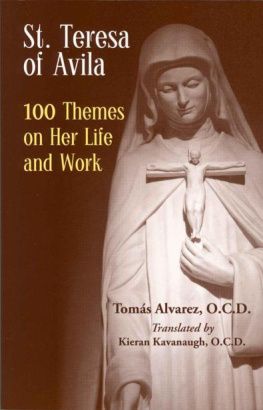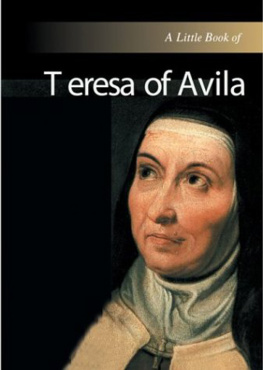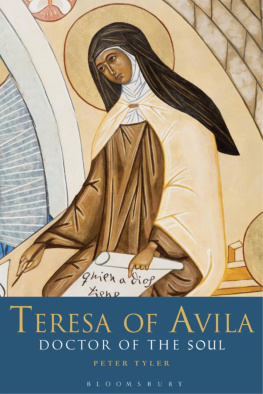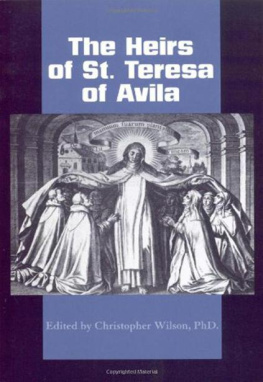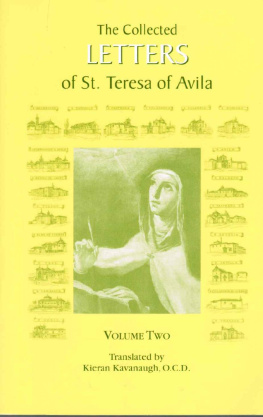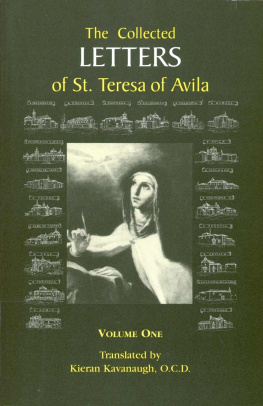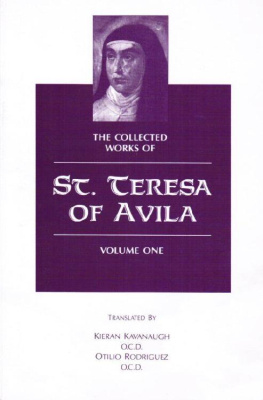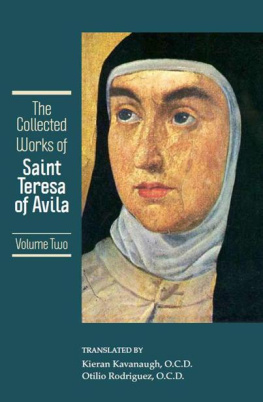We are interested in situating St. Teresa in her cultural and social context. We will explore this from a strictly teresian perspective: only those periods and social aspects that are related to Teresa or that in some way may have conditioned her existence. First of all, we will give an elemental presentation of the person of Teresa and in an appendix we will present her portrait.
1. Saint Teresa: General Data
Her family name was Teresa Sanchez de Cepeda y Ahumada, although she signed her name simply Teresa de Ahumada. From the time of her foundation of the new Carmel, she signed her name Teresa of Jesus, or rather Teresa of Jesus Carmelite. She had no academic titles. Some of her well known posthumous titles are: Mother Founder, the Saint, Mother of Spiritual Seekers, Mystical Doctor, Doctor of the Church, and Patroness, in many different respects [Patroness of Spain is one that is highly contested], Teresa of Avila to distinguish her from Thrse of Lisieux, and so on.
DATES THAT MARK THE COURSE OF HER LIFE:
1515: She was born in Avila - died in Alba de Tormes, 1582 at age 67
1529: Her mother died when she was fourteen years old.
1535: She entered the Carmelite monastery of the Incarnation; made profession in 1537.
1539: She became sick and went to Becedas for a cure; a paralysis followed.
1543: Her father died when she was 28 years old.
1554: She underwent a profound conversion; a new life began, one of maturity and plenitude.
1554: Her mystical life began: an experience of the Christian mystery.
1560. She began her work as a writer: her first writing to reach us is Spiritual Testimony 1.
1562: She began her task as founder: the foundation of her first Carmel, in Avila
1567: Her first exit as founder: the journey to Medina del Campo.
1575: Her brother Lorenzo and his family returned to Spain from the Indies.
1581: Her last journey: Avila-Burgos-Alba de Tormes.
1582: Her death in Alba de Tormes (4-15 October 1582).
THE MOST NOTABLE PERIODS IN HER LIFE:
20 years in her paternal home (1515-1535)
27 years in the Carmelite monastery of the Incarnation (1535-1562)
28 Years of profound mystical experience (1554-1582)
22 Years as writer and founder (1560-1582)
THE GEOGRAPHICAL BOUNDARIES OF
TERESA THE GADABOUT
Her real geography : Teresa traveled about a thousand miles in a covered wagon or riding a mule or on foot. She founded Carmels in Avila, Medina, Valladolid, Toledo, Malagn, Salamanca, Alba, Pastrana (Guadalajara), Segovia, Beas (Jan), Sevilla, Villanueva de la Jara (Cuenca), Palencia, Soria, Burgos. She collaborated in foundations of the friars in Duruelo and Pastrana. Other travels took her to Gotarrendura, Guadalupe, Madrid, Torrijos, Becedas,.
The geography of her mental world was much more spacious than the former. In Spain: Caravaca, (Murcia), Granada, Cantabria, the Basque Country, Valencia, Pamplona, and Barcelona. In Europe: France, Italy, Portugal, and Poland; Africa, Turkey, Abyssinia, and Japan; Above all, South America, where she sent numerous letters, with much tension and stress because of her brothers and in favor of the Indians, and as a prolongation of her mystical life (cases of bilocation?).
Writer : Teresa is a writer, but not one who sought to publish. About 2,000 autograph pages have reached us, but she wrote much more than this, the greater part in Avila:
Four major works: Her Life, The Way of Perfection, The Interior Castle , and The Foundations .
Various minor works: Meditations on The Song of Songs , Spiritual Testimonies , Constitutions, On Making a Visitation , Soliloquies , and Poems.
Letters: almost five hundred have come down to us, but she must have written a couple thousand. (Over a hundred to Padre Gracin).
Lost writings : In addition to the lost letters (all of her correspondence with St. John of the Cross), various Spiritual Testimonies, the first redaction of her Life , a part of her Meditations on the Song of Songs, and an unknown writing when she was fourteen years of age in the style of a novel of chivalry.
Among all of her writings, her Life is the most introspective, the best evaluation of her own life. The Interior Castle is her best doctrinal synthesis. The Way of Perfection is her best pedagogical work, the only work she decided to publish during her lifetime, although it wasn't actually published until after her death, in 1583 in Evora.
Characteristics: Teresa is a woman from Avila, a Carmelite nun, a mystic and a humanist, contemplative and active, a self-taught writer, a founder and a leader, an enterprising, business woman, a saint, a teacher, and a spiritual mother.
Fragile Health . Chronically ill, but psychically strong, her spirit never succumbed to her bodily illnesses; open to transcendental values: to God, Christ, the church, the soul ; ready to undertake daily tasks [a good cook]. Among the traits of greater contrast: her sense of transcendence (the mystical), and her gifts for business and social life (realism and humanism)..

